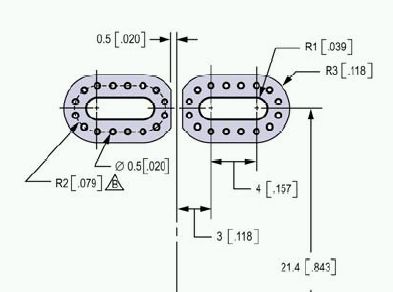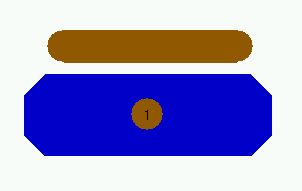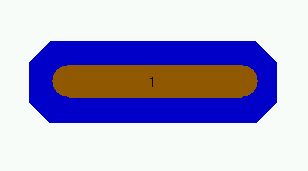Oblong hole
also see:
- Pad
- Aura
- SMD
- Solder paste
- Solder stop
- Test points
- Thermal Pads
- Used pins/pads
- Via
- Drillhole
- Soldering pad having different auras upon different layers
- Two pads leading one signal
Oblong holes in datasheets often are displayed that way:

Image 1: Two oblong holes
An oblong hole is a "Drillhole" brought to length. Others call it a slotted drill or a slotted hole. It is manufactured by a milling tool. Such a tool at least shall be 1 mm strong. In consequence the slot will be 1 mm wide. Smaller slots are difficult to mill. In TARGET 3001! please define millings on layer 25, Milling or on layer 23, Outline because outlines get milled anyway.
If an oblong hole shall be surrounded by copper and plated through, please draw a pad showing the desired copper shape and create the oblong hole as a milling. The milling itself you draw as a line having the desired dimensions upon the milling layer (by default layer 25, Milling). Select the drawing tool from the tool bar and press M2 on the milling layer in the side bar. The width/length of the drawn line defines the dimensions of the milling.
The following image shows the principle of creating a lengthened octagonal pad having a drill hole and having a milling command over it on layer 25 (brown). Change the pad form to "Oblong" in the pad dialog.

Image 2: An individually shaped pad with a milling command on top of it
Now push the milling in position using M1H.

Image 3: A pad with an oblong hole
Your PCB house will mill the oblong hole accordingly. Normally the rule applies: "As long as a copper rest ring remains around the drilling, the figure gets plated through." This is not always the same with milling. Because it depends on the question when the milling will be done: Prior to the plating or afterwards. For clarifying the situation with your PCB-house you should add a little explanatory text in respect to the milling here.
You also might place the milling on layer 23, Outline. Outline information gets milled anyway. Regarding the "plating through" in this case please contact your PCB house how they handle such.
.

